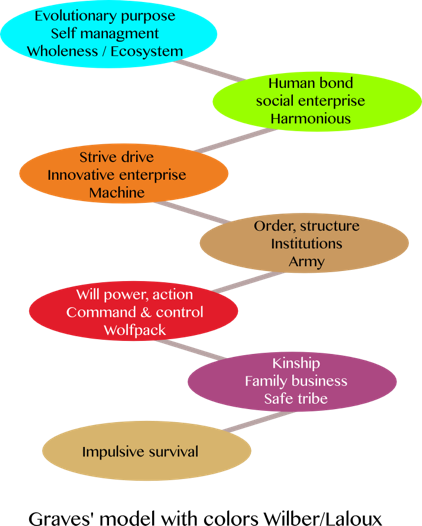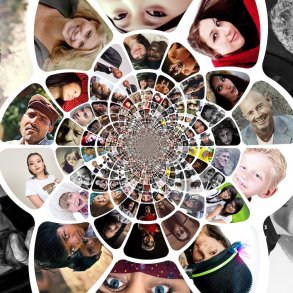By Auke van Nimwegen for Enlivening Edge
Lately there is a lot of interest in what is called Teal organizations, thanks to the book Reinventing Organizations from Frederic Laloux. His description of how organizations can function beyond the paradigm of control, and in a manner that they are humane for the people who work there, clearly strikes a nerve—it seems especially with younger generations.
Teal, derived from the work of Clare W. Graves, is however much more than a new type of organizational culture.
Laloux states that most people who work in today’s Western organizations are disengaged and do not feel happy or nurtured in the work culture. Exact numbers vary but after years of coaching and consulting to various organizations I can only agree with his analysis: most of our organizations are not human-friendly anymore. Laloux’s book is a manifesto which probably attracts so much attention because so many disillusioned people see the possibility of change. ‘Yes we can! We are not crazy.’
It is not that we failed to adjust, but that the cultures we work in no longer suit us; many of us have outgrown them. The examples in Laloux’s book are evidence that it is possible to create a work environment which nurtures, trusts people, brings out the best in them, and lets them be who they are without ‘professional’ masks or adjusted behavior.
The mismatch Frederic Laloux talks about is visible in the assessments we have done in organizations in the last 5 years using the ValueMatch instruments. With a few exceptions it shows that the employees desire a more complex, human friendly workplace than the current cultures that are often too hierarchical or power driven. This leads to much frustration, dissatisfaction and burnouts. It also shows that the human potentials for Teal organizations is present in many places.
 Laloux explains the different organizational cultures based on the work of Clare W. Graves. As a professor, Graves did decades of research into what drives human behavior. From his data he derived a model which shows how our society gets more complex in distinct steps, and that humans evolve to a more complex way of thinking with each step.
Laloux explains the different organizational cultures based on the work of Clare W. Graves. As a professor, Graves did decades of research into what drives human behavior. From his data he derived a model which shows how our society gets more complex in distinct steps, and that humans evolve to a more complex way of thinking with each step.
What people value, and what drives them, also changes in each stage of development. For example, people in tribal society are driven by creating safety for the survival of the tribe, which is distinctly different from a stock broker in today’s market society who is driven by the desire to be successful and to win the game.
As the model of Graves can be applied to individuals, teams, organizations and society, Laloux has used it to describe the various stages of development of organizations. His descriptions include the market-driven Orange organization, the people-driven Green organization, and primarily the next step beyond Green in the evolution of organizations, Teal.[i]
The wider picture of why this development is happening
As most of the attention that Laloux’s work gets is focused now on creating human-friendly workplaces, it is easy to forget the wider picture of why this development is happening at this moment in our history. For sure, it is time to have workplaces which make people thrive rather than burn them out. It is time to make work an integral part of our life which can be as enjoyable as “non-work.” These changes also make sense because people perform much better in humane conditions, making the organization more effective.
However, if we go back to Graves’ work we see that a new human mindset, drive, or set of values, is always a response to deal with and survive in new life conditions. Our world today is a total mess; we cannot survive as a species if we continue life the way we behave now. Our Orange mindset—with the drive to be successful, to win the game and with the urge to create a higher quality of life for ourselves—has depleted the resources of the planet and created unsustainable inequality between people. The planet simply is too small for all of us to just focus on our personal success. This mindset has built organizations which are focused on results and their own growth. They are destructive for employees who are driven into burnout (especially if their own mindset does not match the Orange drive). These organizations have now become parasites to the planet and society.
The Green mindset and drives have brought humanness into society by demanding equal rights for various kinds of humans, and by regarding every human on the planet as equally valuable. However, since it is driven by creating personal harmony above all else, it has failed to address the real issues which threaten our life style. The Green drive for harmony in organizations often creates much better workplaces, but it can become a pitfall if harmony becomes paramount to the purpose of the organization, resulting in endless meetings which fail to make real decisions.
Teal (or Yellow in the model of Beck and Cowan) arises in response to the current life conditions. Its focus is clear and simple: to create a way of life that in the words of Graves ‘allows us to be more than just a parasite to this planet’. As this mindset develops in humans, their focus becomes creating a way of life that makes it possible for our species to survive given the current life conditions.
What this means now
This means, at this moment in history, that we need to build a society and organizations which see the planet as an interconnected system with humans participating in a healthy way. Our interaction with nature, our environment, and the planet should be such that life can thrive and no finite resources are depleted. Our garbage should be compost leading to new life; our materials should be totally recyclable into new products (see also the Cradle-to-Cradle concept). We need to treat each other in a way that supports each human and extends love rather than hate—not only because it feels better for those involved in the interaction, but because if we don’t, we simply won’t survive on a planet with so many humans intimately interconnected. Hate against strangers allowed isolated tribes to defend themselves and survive, but in the global village we have now become, it threatens the existence of all of us.
This all might sound daunting and seem fear-driven. Daunting it is, but the fear we possibly feel around this is our old programming. All human systems up through Green are in fact fear-driven, which makes it so hard to deal with the current challenges. The fear in Orange, of not being successful, makes people focus primarily on their own need. The fear in Green, of not belonging, makes process and harmony in organizations more important than results. Fear in Green also prevents these organizations from exploring new solutions and taking on big tasks beyond their comfort zone.
People operating from Teal might be aware of still having those fears, but they don’t act on fear. They don’t let it block their creativity nor their fun in life. They find joy in taking on challenges which go beyond their known capacity, and in doing so, maximize their creativity. William McDonough is one of the creators of the Cradle-to-Cradle concept; he helped to transform Ford Motor company’s heavily-polluted Rouge River Plant into an ecological environment ‘clean enough for children to play in’. According to him, when they took on the project it was a challenge and they did not have all the solutions to make it happen. Yet they accepted the challenge; their drive to create something new was larger than their fear of failure.
For organizations, awareness of the wider context of their functioning means first and foremost that their purpose has to contribute to life in a healthy, sustainable way, supporting all life on this planet. As Laloux describes Evolutionary Purpose, we should be aware that this is essentially there for the survival of the species, and that it should affect all our interaction with the environment, with our business partners, customers, and all living creatures on this planet. The Evolutionary Purpose should contribute to a healthy eco-system, and none of our services or products should pollute or harm others, else the organization can’t be called Teal in the way Graves defined that stage.
The complexity of the solutions we require to survive, technically, medically, socially, and environmentally, is enormous. Graves stated that our next leap in development [into what Laloux calls “Teal”] is bigger and more complex than all our previous steps together. Yet, much of our creative capacity in today’s traditional organizations is lost in stress, burnout, conflicts, and people trying to adjust their behavior. Efforts to bring in new creative methods such as Agile can be helpful, but often do not address the core issues in the culture, let alone take us into that leap.
So from an evolutionary perspective the Teal, humane, way of organizing that Laloux describes is crucial in order to free up as much creative capacity in people as possible. That capacity can enable us to find solutions which will help our species survive.
When people are trusted and feel safe, and are free to find the best way, their capacities contribute to the whole organization; all their energy is available for the work they do, and their creativity soars. Just look at how much more creative young children are who have not yet learned to adjust to the controlling structures of school and our learning institutes—which are designed for a hierarchical, controlled, and personal-success-driven (Orange) society.
When we are aware of this wider context, we will create workplaces which are humane, which engage people and make them passionate about work again. In fact, we might just become even more passionate and engaged if we realize we are contributing to a healthy form of life and to the survival of our species.
Thanks to Jon Freeman for reviewing and John Miller for his knowledge on Agile.
Sources:
Reinventing Organizations, Frederic Laloux (available in many languages), 2014
The Never Ending Quest, Clare W. Graves. Edited by Christopher Cowan and Natasha Todorovic. Only available via de Clare W. Graves website: http://www.clarewgraves.com
Spiral Dynamics: Mastering Values, Leadership and Change, Don Beck and Christopher Cowan. Reprint edition 2005.
Cradle to Cradle: Remaking the Way We Make Things, Michael Braungart & William McDonough. 2002.
Documentary ‘Afval is Voedsel’ (Garbage is food), VPRO Tegenlicht, 2007, The Netherlands. On Cradle to Cradle and the River Rouge project.
Website William McDonough http://www.mcdonough.com/
ValueMatch instruments based on the work of Clare W. Graves, Beck and Cowan, www.valuematch.net
[i] Don Beck and Christopher Cowan brought Graves’ work into the world under the name of Spiral Dynamics. Others have adopted it and Laloux has used the colors Ken Wilber assigned to the various stages of development. The original Spiral Dynamics uses ‘Yellow”\’ not ‘Teal’.

Auke van Nimwegen is a coach, consultant, trainer, and developer of integral instruments. He works with individuals, organizations, and social projects at the crossroads of personal development, collective culture, and new-paradigm solutions. ValueMatch, www.valuematch.net





Thanks for this clearly worded artical. Especially the sentence: “These organizations have now become parasites to the planet and society” is helpful to wake up and change the belief that organizations are conductive pillars. In my experience the organisations have often developed slower then the majority of their employees. Hopefully Value Match and other Instruments which show the gap in development stages in “number and graph” (;-)) help orange organisations to see the chance of change.
Utterly brilliant article and superb introduction and summary for those being introduced to Teal Organisations, Laloux’s work and that of Wilber, Beck and Graves et al. Surely anyone reading this would feel relieved and energised knowing there is a better way to run organisations and for us all to live and work meaningfully and purposefully. Greats share. Thank you.
Great article and indeed the gap between ‘organizations have become parasites to the planet and society’ and the teal promise of ‘evolutionary purpose’, ‘wholeness’ and ‘self-management’ needs to be bridged. For that, know-how and especially ‘show-how’ in facilitating organizations to bridge that gap are vital. And it should be done in a teal/yellow way and it requires a transformational rather than a ‘transactional’ change process: move from ‘old’ to ‘new’ in the way of ‘new’. That in turn requires facilitating transformational change process in individuals (leaders and professionals alike), teams, organizations, industries and society.
That has been the focus of my change endeavours the last five years and training ‘frontrunners’ as change coaches/change facilitators/change conductors has been a cornerstone in that approach.
I would welcome an article on the change parameters of transforming from orange, via green to teal/yellow. Shall we co-write it, Auke?
Beautify and powerful article I just discover it almost 8 years late – it article hasn’t aged a day.